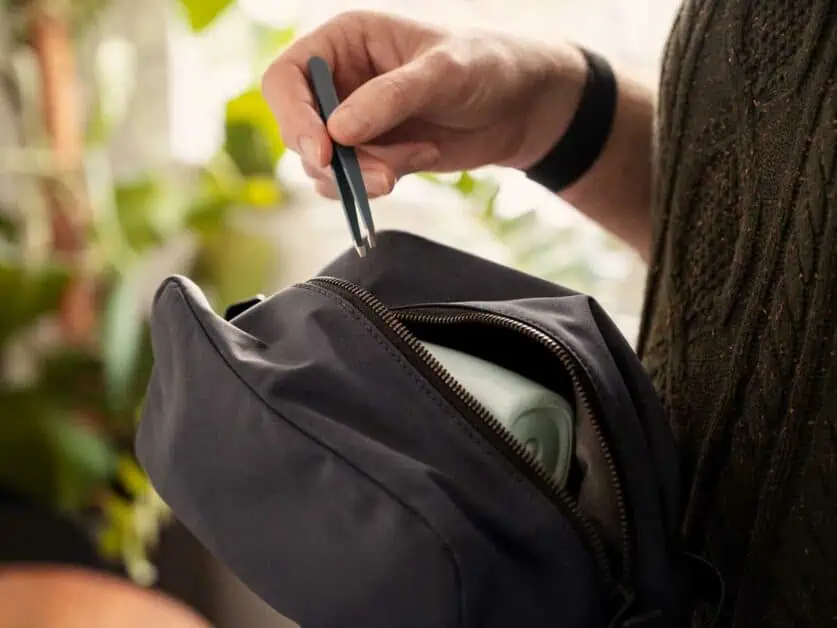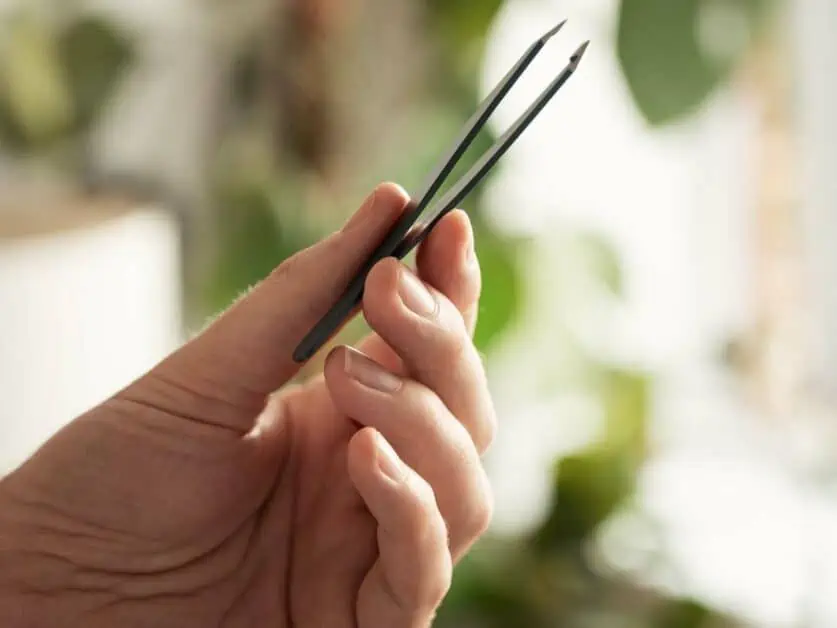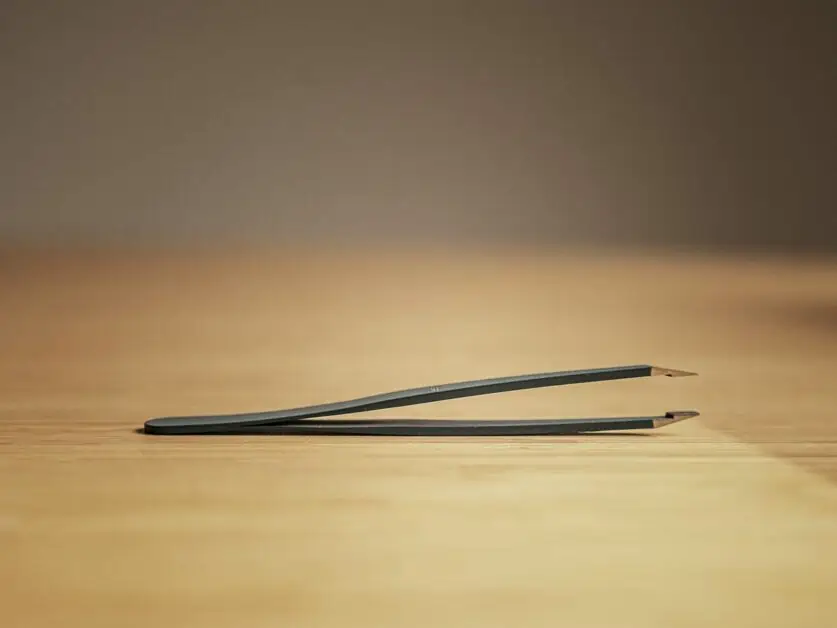Packing for a trip away can be complicated by figuring out what items can be taken in your carry-on bags. While some things are clearly prohibited, others are not so obvious. Tweezers are one of the things that cause confusion. Regrettably, there is no simple answer. Some countries and airlines state that you can have tweezers in your hand luggage; some say you can’t, and some don’t specify either way. The final decision is always down to the security officer checking your bags. If possible, always pack your tweezers in a suitcase that is going in the hold.
Table of Contents
ToggleWhy Wouldn’t You Be Allowed to Take Tweezers in Carry-On Luggage?
So why would there be an issue with taking your tweezers on a plane?
- They can be used as a weapon. While to you tweezers are just a tool for plucking your eyebrows, much the same as nail clippers are for clipping nails, they could, in theory, be used as a weapon. Anything metal with sharp edges or a pointed end can be classified as dangerous.
- They could cause an injury. The safety of the staff who check through people’s bags is important. Having something in your luggage with a sharp point could cause an injury.
- They could damage equipment. Tweezers are small but usually made of metal. If a pair fell out of your bag and got caught in the machinery in the scanner, it could cause damage. This would create delays and expense.

So, Can I Bring My Tweezers on a Plane as Carry-On Luggage?
There is no definitive answer to this question. The guidelines vary from country to country.
America – What Does the TSA Say About Tweezers?
The Transportation Security Administration (TSA) states that tweezers are allowed in both carry-on bags and checked bags. They request that anything sharp, including tweezers, be well-wrapped to ensure it can’t cause any injuries. See what the United States TSA says about bringing tweezers on a plane here.
The UK – What Are the UK Government’s Regulations Concerning Tweezers in Hand Luggage?
The UK includes tweezers in their list of personal items that are allowed in hand luggage. See what the UK gov.uk website says about bringing tweezers on a plane here.
Europe – What Are the EU’s Guidelines Regarding Tweezers in Carry-On Bags?
The EU guidelines do not specifically mention tweezers in their list of items that are not permitted in your cabin baggage. They have a category for objects with a sharp point or sharp edge capable of being used to cause serious injury that are forbidden. This includes knives, razor blades, and scissors. However, if the item is less than six centimeters, it is acceptable to be in your carry-on luggage. Logically, if you have tweezers that are less than six centimeters long, there shouldn’t be a problem. It is possible, though, for a security officer to decide that your tweezers are a sharp object, and they can remove them if they choose. See what the European transport.ec.europa.eu website says about bringing tweezers on a plane here.
Australia – Does the ABF Have Laws About Tweezers?
Like the EU, the Australian Border Force (ABF) does not explicitly mention tweezers in their lists of items you can’t take on a plane. A list about twenty years ago included things like nail clippers, pointed metal files, and tweezers, but it has since been updated, and they are no longer mentioned. Instead, there is a general classification of items with sharp edges or points capable of injuring someone with examples of what is not allowed. No pointed metal scissors, manicure scissors, or scissors with blades more than six centimeters long can go in your cabin baggage. You are permitted blunt-ended or round-ended scissors with blades less than 6cm long. So you should, in theory, be OK with tweezers under six centimeters long. You cannot be certain, though; as always, it is up to the judgment of the security officer checking your bags. See what the Australian homeaffairs.gov.au website says about bringing tweezers on a plane here.
New Zealand – What Are the CAA of New Zealand’s Rules About Tweezers?
When you first look at the Civil Aviation Authority of New Zealand (CAA) regulations on their webpage, you will most likely think that tweezers are not allowed in your carry-on bags. In the section ‘Personal security, grooming, toiletries, aerosols’, the list of prohibited items starts with ‘Items with a sharp edge or point, except blunt-end scissors with a blade less than 6cm long’. This description would appear to fit tweezers. However. If you look further down under ‘Tools and sharp objects’, the allowed list includes ‘Tweezers, knitting needles, crochet hooks’. This would seem to indicate that tweezers are allowed in your cabin baggage. See what the Air New Zealand website says about bringing tweezers on a plane here.
Canada – What Does the CBSA Say About Tweezers?
The Canada Border Services Agency (CBSA) very clearly lists tweezers as personal items that are sharp objects but are permitted to be in your carry-on bags in the cabin. See what the Canadian CBSA website says about bringing tweezers on a plane here.
The Rest of the World
If you are flying in areas such as South America, Asia, or Africa, you will probably be in more than one country. The simplest thing to do is to check with your airline if they have regulations about bringing your tweezers onboard in hand baggage. Most of the big airlines will not permit you to have tweezers in your carry-on bag; they have to be in a checked suitcase in the hold.
- https://www.singaporeair.com/en_UK/us/travel-info/baggage/baggage-restrictions/
- https://www.ethiopianairlines.com/aa/information/baggage-information/restricted-items
- https://www.latamairlines.com/gb/en/help-center/faq/baggage/cabin/prohibited-item
- https://www.china-airlines.com/tw/en/fly/prepare-for-the-fly/baggage/carry-on-baggage

See other articles in this series:
- Can you Bring Nail Clippers on a Plane?
- Can You Bring Hiking Sticks or Poles on a Plane?
- Can You Bring a Lighter on a Plane?
- Can You Bring Shampoo on a Plane?
- Can You Bring Razors on a Plane?
- Can You Bring Curling Irons on a Plane?
- Can You Bring Deodorants on a Plane?
- Can You Bring Candles on a Plane?
- Can You Bring Scissors on a Plane?
What’s the Best Advice for Travelling on a Plane with Tweezers?
If possible, do not bring tweezers in your hand luggage. Even in countries like America, Canada, and the UK that state tweezers are allowed in the plane’s cabin, it is still up to the judgment of the security officer who can refuse to let you take them onboard. The only safe way to travel on a plane with tweezers is to pack them in a suitcase in the hold.
You need to be aware that if you choose to take your tweezers in your carry-on bag, there is a chance you might lose them. If your tweezers are expensive, part of a manicure set, or have a sentimental attachment, you won’t want to risk losing them. If putting them in your checked baggage is not an option, then it would be sensible to leave them at home. If you think you will not be able to manage on your trip without tweezers, then it might be a good idea to buy a cheap pair for traveling.
If you are in circumstances where you have to bring tweezers in your carry-on bag, then it would be sensible to take steps to reduce the possibility of a security officer viewing them as a problem.
- Ensure they can’t be used as a weapon. Put your tweezers in a place in your bag that is not easily accessible. A security officer could view them as a potential threat if they are loose in an outside pocket. This is less likely to happen if they are packed away in a wash bag or tucked into the pocket of trousers.
- Ensure they can’t cause an injury. Packing your tweezers away will also help to reduce the chances of them injuring anyone. The pointed end of the tweezers is the primary concern, so you could tape some cotton wool or a scrap of soft material over the ends.
- Ensure they can’t damage equipment. The TSA suggests putting sharp objects in a sheath. If you have the original packaging of the tweezers, you could use that to transport them. Alternatively, you could make a small bag for them if you like sewing. The easiest thing to do, though, would be to wrap them in a piece of material and secure it with something like a ribbon.
What Happens If Your Tweezers Are Flagged by Airport Security?
If you have put your tweezers in your carry-on bag and they are flagged by security, don’t panic. The tray with your bag in it will be taken off the conveyor belt and moved to a holding area, where a security officer will inspect it. You should collect any of your belongings that have been cleared through and then make your way round to where your bag has been taken. The security officer will need to examine the contents of your bag. The usual process is to ask you to empty everything out of your bag, but sometimes, they will tip everything out of your bag into a tray themselves.
The vital thing in this situation is to remember that the security officer is not trying to make your life difficult. Their job is to keep everyone traveling on the planes leaving from their airport safe. We all want them to do their job well, and they have a lot of responsibility. Being rude because they are double-checking your bags is unnecessary and unhelpful.
If your tweezers have been flagged on the scanning machine, you may find that if you are polite and reasonable, you can keep them. However, if the security officer decides the tweezers are not permitted in your hand luggage, there is no point arguing. In some countries, the security officers can impose fines or refuse to allow you to fly. If your tweezers are removed from your luggage, they are usually handed to the airline you are flying with. You may be able to arrange to collect them, but items removed at security are generally only kept for a few days before being disposed of.

Does the Type of Tweezers Make a Difference to Them Being Allowed On a Plane?
Looking at the guidelines for which items are allowed on a plane, the main reason tweezers would not be allowed in your cabin baggage is that they may be viewed as a sharp object that could potentially be a weapon. The bigger your tweezers and the more pointed their ends are, the more likely it is that they will be removed by security. Scissors and knives with blades under six centimeters or four inches are generally allowed. Therefore, if your tweezers are longer than six centimeters or four inches, they are more likely to cause concern.
These are the main types of tweezers:
Slanted tweezers: These have angled tips that allow you to isolate individual hairs. They are used primarily for eyebrow shaping and hair removal.
Pointed tweezers: These have tips with precision points, making them useful for delicate tasks requiring pinpoint accuracy. They are chiefly used for removing anything embedded under the skin, such as ingrown hairs and splinters, and applying false eyelashes. They are also used in crafting for things like jewelry-making or model assembly.
Pointed slant tweezers: These are a combination of pointed and slanted tweezers. Their primary use is as an eyebrow hair plucker, but they are particularly good at grabbing coarse hair and short stubble hairs. They are also helpful for handling tiny components in craft-making.
Flat-edged tweezers: Square-tip tweezers, also known as flat or straight-tip tweezers, are the most common type. Although they can be used as a brow plucker, they also have many other uses. They are usually part of first aid kits. They are used for precisely manipulating small objects in activities such as crafting and food presentation.
Arched claw tweezers: These have a pronounced curve on each side that comes to a point. They are used chiefly after waxing to pluck stray hairs in hard-to-reach areas.
Round tip tweezers: These have rounded ends and are probably the easiest to take on a plane. They are not very accurate, so they are used more for holding things than eyebrow hair plucking. They are also used for removing ticks.
Serrated tweezers: These have ridges on their edges to give a better grip. They are ideal when you need precise handling of small objects.
Conclusion
Working out whether you can bring your tweezers on a plane is not easy. You can definitely pack them in a suitcase that is going in the hold, preferably with the sharp end wrapped to protect security officers if they need to check your bags. However, if you want to take them in your cabin bag, you may encounter problems at security. Some countries, such as America, Canada, New Zealand, and the UK, list tweezers as items that are allowed in hand luggage. Other countries, such as Australia and the EU, leave it to your judgment to decide if they qualify as sharp objects that are prohibited or not. Regardless of the guidelines, the final decision belongs to the security officer checking your bags. Therefore, you cannot be certain that they will not be confiscated if you bring your tweezers in your carry-on.
